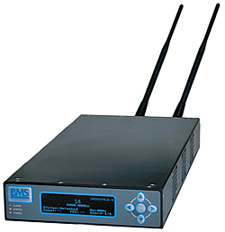BMS Wins Over Missouri Skeptic

The BMS dual antenna microwave receiverSPRINGFIELD, MO.
Last year in connection with a new basketball arena here, I was asked to put together a system for displaying the action on large video displays. Plans called for a fiber run between the arena's video control room and an existing football stadium about a mile away. The stadium was also getting a new video display and the university didn't want to duplicate control rooms.
ROVING CAMERA A MUST
Everyone agreed a critical item for both facilities was a wireless camera. In covering either event on the big screen, the foremost need was to have an un-tethered camera that was free to roam the action. However, the budget was tight and spending some $50,000 for the wireless components was not met with a lot of enthusiasm.
As the design process moved forward, we hoped that we could find a wireless system that would both meet our needs and come in at a figure we could afford. We looked for a system that was easy to operate, had a simple RF licensing process, could be conveniently moved between venues and didn't introduce a lot of video delay.
Many of the systems we evaluated had great specs and accommodated a lot of camera movement inside. Good coverage was partly due to high transmitter output level and the use of multiple high gain receive antennas. The downside was that the cost of the antennas, along with their associated block down-converters, transmission line and installation costs really pushed up the total.
It was then that we looked at the CT2430LD camera transmitter from Broadcast Microwave Services. This is a small COFDM digital transmitter that easily fits between the back of the camera and a brick-type battery and works with either analog or SDI video. MPEG-2 encoding is done internally.
I'M FROM MISSOURI: SHOW ME!
I wasn't sure, though, that the small diversity receiver recommended by Jim Kubit of BMS would actually work in our large sports venues. It has dual receiving antennas mounted directly to it, limiting antenna placement. However, if it worked as well as Jim indicated, it would really make life a lot simpler as we moved gear around between the two sports centers. Not having to install coax and large directional antennas would really be a blessing. I remained somewhat skeptical until Jim sent a demo unit.
I had the system up and running in less than 10 minutes—really plug and play. There are only three buttons on the receiver and transmitter. The transmitter provides up to one watt of output power while only drawing 12 watts. Installation only amounted to placing it on the camera and connecting a video cable. The receiver came with an internal MPEG-2 decoder and directly provides either analog or SDI video. There's no need to purchase an external ASI decoder. The system also accommodates two channels of audio.
Testing at the football stadium provided excellent results. With the receiver placed on a table in the press box we had great pictures with the camera roaming all over the field and under the bleacher seating. We got the same results in the arena. The decision to purchase was easy. Based on the cost of BMS unit, along with its performance and size, nothing else comes close.
Brent Moore is chief engineer for the Ozarks Public Television operation based at Missouri State University. He may be contacted atbrentmoore@MissouriState.edu.
For additional information, contact Broadcast Microwave Services at 800-669-9667 or visitwww.bms-inc.com.
Get the TV Tech Newsletter
The professional video industry's #1 source for news, trends and product and tech information. Sign up below.
